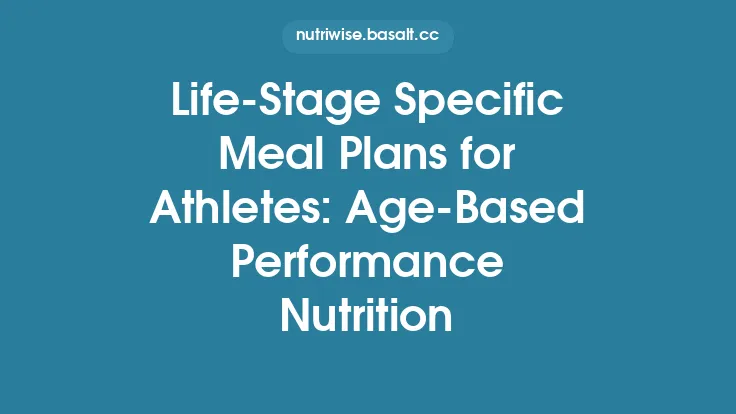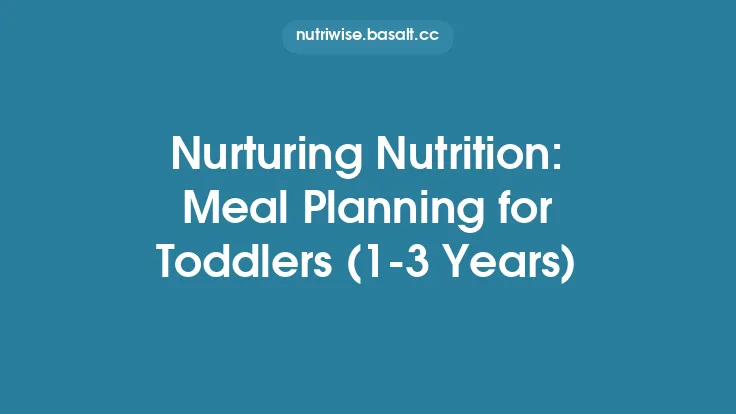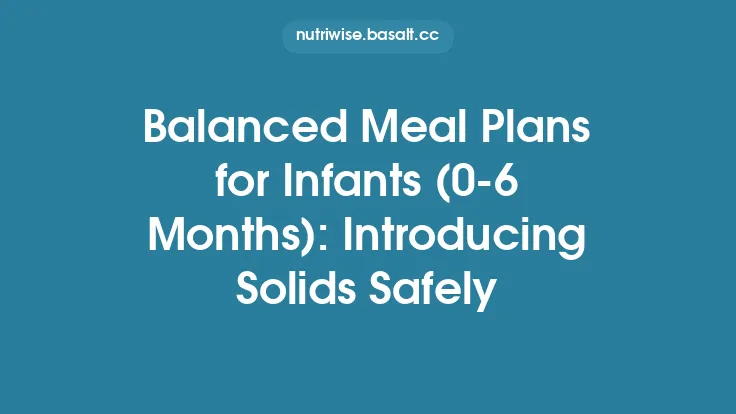Pregnancy is a unique physiological state that demands careful attention to nutrition. The developing fetus, the expanding uterus, and the mother’s own changing body all rely on a steady supply of macro‑ and micronutrients. While the overall goal is to support healthy growth and prepare for labor, the specific nutritional priorities shift as pregnancy progresses. Tailoring meal plans to each trimester helps ensure that both mother and baby receive the right balance of calories, protein, essential vitamins, and minerals at the right times.
First Trimester: Foundations for Growth
Caloric and Macronutrient Needs
- Calorie increase: Roughly 150–200 kcal extra per day above pre‑pregnancy needs.
- Protein: Aim for 1.1 g/kg body weight (≈ 70 g for a 140‑lb woman). Protein supports early tissue formation and the rapid cell division occurring in the embryo.
- Carbohydrates: 45–65 % of total calories, focusing on complex carbs (whole grains, legumes, starchy vegetables) to provide a steady glucose supply.
- Fats: 25–35 % of calories, with an emphasis on omega‑3 fatty acids (especially DHA) for neural development.
Key Micronutrients
| Nutrient | Recommended Daily Allowance (RDA) | Primary Food Sources |
|---|
| Folate (folic acid) | 600 µg DFE | Dark leafy greens, fortified cereals, legumes, citrus |
| Iron | 27 mg | Lean red meat, poultry, lentils, fortified grains |
| Vitamin B12 | 2.6 µg | Animal products, fortified plant milks |
| Vitamin D | 600 IU | Fatty fish, fortified dairy/plant milks, sunlight |
| Iodine | 220 µg | Iodized salt, dairy, seaweed (in moderation) |
| Choline | 450 mg | Eggs, soybeans, quinoa, broccoli |
Sample Day (≈ 2,200 kcal)
| Meal | Foods | Approx. Nutrients |
|---|
| Breakfast | Greek yogurt parfait with ½ cup mixed berries, ¼ cup granola, and a tablespoon chia seeds | 20 g protein, 12 µg folate, 300 mg calcium |
| Mid‑morning snack | Whole‑grain toast with avocado and a hard‑boiled egg | 10 g protein, 150 µg folate, 2 µg vitamin B12 |
| Lunch | Quinoa salad with chickpeas, spinach, roasted sweet potato, and lemon‑tahini dressing | 18 g protein, 250 µg folate, 3 mg iron |
| Afternoon snack | Apple slices with almond butter | 5 g protein, 1 µg vitamin D (from fortified almond butter) |
| Dinner | Baked salmon (4 oz), brown rice, steamed broccoli, and a side of mixed greens with olive oil | 30 g protein, 1,200 IU vitamin D, 2 mg iron |
| Evening snack | Warm milk (or fortified plant milk) with a dash of cinnamon | 8 g protein, 300 mg calcium |
Practical Tips
- Spread folate intake throughout the day; supplement with a prenatal vitamin containing 400–800 µg DFE if dietary intake is insufficient.
- Combat nausea by eating small, frequent meals and incorporating ginger or peppermint tea.
- Hydration: Aim for 2.5–3 L of fluids daily, including water, herbal teas, and soups.
Second Trimester: Supporting Rapid Development
Caloric and Macronutrient Adjustments
- Calorie increase: Add 340 kcal per day above pre‑pregnancy needs (≈ 2,300–2,500 kcal total).
- Protein: Increase to 1.2 g/kg (≈ 75–80 g).
- Carbohydrates: Maintain 45–65 % of calories; prioritize fiber‑rich sources to prevent constipation.
- Fats: Continue 25–35 % of calories, ensuring at least 200 mg DHA daily (≈ 2 servings of low‑mercury fish per week).
Critical Micronutrients
| Nutrient | RDA | Why It Matters in Trimester 2 |
|---|
| Calcium | 1,000 mg | Bone mineralization for both mother and fetus |
| Vitamin C | 85 mg | Enhances iron absorption, supports immune function |
| Magnesium | 350 mg | Helps with muscle relaxation and reduces leg cramps |
| Zinc | 11 mg | Supports DNA synthesis and immune health |
| Vitamin K | 90 µg | Important for blood clotting and bone health |
Sample Day (≈ 2,400 kcal)
| Meal | Foods | Approx. Nutrients |
|---|
| Breakfast | Oatmeal cooked in fortified soy milk, topped with sliced banana, walnuts, and a drizzle of honey | 15 g protein, 300 mg calcium, 2 mg iron |
| Mid‑morning snack | Cottage cheese with pineapple chunks | 12 g protein, 200 mg calcium |
| Lunch | Turkey and avocado wrap on a whole‑grain tortilla, side of carrot sticks and hummus | 25 g protein, 400 µg folate, 2 mg iron |
| Afternoon snack | Smoothie: spinach, frozen mango, Greek yogurt, chia seeds, and fortified orange juice | 10 g protein, 500 µg folate, 600 IU vitamin D |
| Dinner | Stir‑fried tofu with bok choy, bell peppers, and brown rice, seasoned with ginger and low‑sodium soy sauce | 20 g protein, 150 mg calcium, 2 mg iron |
| Evening snack | Dark chocolate (70 % cacao) and a handful of almonds | 5 g protein, 2 mg iron, 1 µg vitamin B12 |
Practical Tips
- Iron absorption: Pair iron‑rich foods with vitamin C sources (e.g., citrus, strawberries).
- Prevent constipation: Include at least 25 g of fiber daily and stay well‑hydrated.
- Manage heartburn: Avoid large meals, limit spicy or acidic foods, and stay upright after eating.
Third Trimester: Preparing for Birth
Caloric and Macronutrient Needs
- Calorie increase: Add 450 kcal per day above pre‑pregnancy needs (≈ 2,600–2,800 kcal total).
- Protein: Target 1.3 g/kg (≈ 85 g).
- Carbohydrates: 45–55 % of calories; focus on low‑glycemic options to maintain stable blood sugar.
- Fats: 30 % of calories, with continued emphasis on DHA and omega‑3s for fetal brain development and to support maternal mood.
Essential Micronutrients
| Nutrient | RDA | Role in Late Pregnancy |
|---|
| Iron | 27 mg | Prevents maternal anemia, supports increased blood volume |
| Vitamin A (beta‑carotene) | 770 µg RAE | Supports lung maturation; avoid preformed retinol > 3,000 µg |
| Vitamin K2 | 90 µg | Contributes to bone health and clotting factors |
| Selenium | 60 µg | Antioxidant protection, thyroid function |
| Vitamin B6 | 1.9 mg | May reduce nausea and support neurotransmitter synthesis |
Sample Day (≈ 2,700 kcal)
| Meal | Foods | Approx. Nutrients |
|---|
| Breakfast | Whole‑grain pancakes topped with almond butter and fresh berries, side of scrambled eggs with spinach | 22 g protein, 400 mg calcium, 2 mg iron |
| Mid‑morning snack | Kefir (or fortified plant kefir) with a sprinkle of flaxseed | 10 g protein, 300 mg calcium, 200 µg folate |
| Lunch | Grilled chicken breast, quinoa pilaf with roasted vegetables, side salad with olive oil‑lemon dressing | 30 g protein, 500 mg potassium, 2 mg iron |
| Afternoon snack | Pear slices with a slice of cheese (or fortified vegan cheese) | 8 g protein, 200 mg calcium |
| Dinner | Baked cod with a herb crust, sweet potato mash, steamed asparagus, and a small serving of lentil soup | 28 g protein, 1,200 IU vitamin D, 3 mg iron |
| Evening snack | Warm fortified oat milk with a dash of turmeric and black pepper | 6 g protein, 300 mg calcium, 400 IU vitamin D |
Practical Tips
- Monitor weight gain: Aim for a total gain of 25–35 lb (11.5–16 kg) for a normal‑weight woman; adjust portions accordingly.
- Blood‑sugar stability: Pair carbs with protein/fat (e.g., apple with peanut butter) to avoid spikes.
- Prepare for labor: Include easy‑to‑digest, energy‑dense foods (e.g., smoothies, nut butter, whole‑grain crackers) for late‑night cravings.
Key Nutrients Across All Trimesters
- Folate – Prevents neural‑tube defects; maintain intake through diet and prenatal supplement.
- Iron – Supports expanded blood volume; monitor ferritin levels, especially if you have a history of anemia.
- Calcium & Vitamin D – Critical for fetal bone formation; aim for 1,000 mg calcium and 600–800 IU vitamin D daily.
- Omega‑3 DHA – Essential for retinal and brain development; 200–300 mg DHA per day is optimal.
- Protein – Provides amino acids for tissue growth; distribute intake evenly across meals.
- Fiber – Prevents constipation and supports gut health; target 25–30 g per day.
- Water – Adequate hydration aids amniotic fluid production and nutrient transport; 2.5–3 L daily.
Practical Meal‑Planning Strategies
- Batch‑cook and freeze: Prepare soups, stews, and grain bases in large quantities; portion into freezer‑safe containers for quick meals.
- Use a “plate method”: Half the plate non‑starchy vegetables, one‑quarter lean protein, one‑quarter whole grains or starchy vegetables.
- Incorporate nutrient‑dense snacks: Keep nuts, seeds, Greek yogurt, and pre‑cut fruit on hand for easy grazing.
- Track micronutrient intake: Simple apps can flag low‑folate or low‑iron days, prompting you to adjust the next meal.
- Plan for cravings: Include a “treat” slot each day (e.g., a small piece of dark chocolate) to satisfy cravings without derailing overall balance.
Sample Weekly Meal Plan (Second Trimester)
| Day | Breakfast | Lunch | Dinner | Snacks |
|---|
| Mon | Whole‑grain toast with avocado, poached egg, orange slices | Lentil salad with feta, cucumber, tomatoes, olive oil‑lemon dressing | Grilled salmon, quinoa, roasted Brussels sprouts | Greek yogurt with honey; carrot sticks with hummus |
| Tue | Smoothie bowl (spinach, frozen berries, fortified soy milk, chia) | Turkey chili with black beans, side of brown rice | Stir‑fried tofu, bok choy, bell peppers, soba noodles | Apple with almond butter; cheese cube |
| Wed | Oatmeal topped with walnuts, banana, and a drizzle of maple syrup | Chicken Caesar wrap (whole‑grain tortilla, romaine, Parmesan, light dressing) | Baked cod, sweet potato wedges, green beans | Cottage cheese with pineapple; mixed nuts |
| Thu | Greek yogurt parfait with granola, kiwi, and pumpkin seeds | Quinoa‑black bean bowl with corn, avocado, salsa | Beef and vegetable kebabs, couscous, side salad | Pear; hard‑boiled egg |
| Fri | Scrambled eggs with spinach, whole‑grain English muffin | Mediterranean chickpea salad (olives, tomatoes, cucumber, feta) | Shrimp stir‑fry with broccoli, carrots, brown rice | Smoothie (mango, kefir, flaxseed); dark chocolate |
| Sat | Pancakes made with whole‑grain flour, topped with berries and a dollop of ricotta | Veggie‑packed minestrone soup, whole‑grain roll | Roast chicken, mashed cauliflower, sautéed kale | Yogurt with granola; orange slices |
| Sun | Breakfast burrito (egg, black beans, salsa, avocado, whole‑grain tortilla) | Tuna salad on mixed greens, quinoa side | Vegetarian lasagna (whole‑grain noodles, ricotta, spinach, tomato sauce) | Trail mix; banana |
*Adjust portion sizes to meet individual calorie targets.*
Managing Common Pregnancy Challenges Through Food
| Challenge | Nutritional Approach | Sample Foods |
|---|
| Morning sickness | Small, frequent meals; bland, low‑fat options; ginger | Crackers, plain toast, ginger tea, banana |
| Heartburn | Avoid trigger foods (spicy, acidic, fatty); eat upright after meals | Oatmeal, baked potatoes, lean poultry, non‑citrus fruits |
| Constipation | High fiber + fluid; probiotic‑rich foods | Lentils, berries, whole‑grain breads, kefir |
| Leg cramps | Magnesium‑rich foods; adequate hydration | Almonds, pumpkin seeds, leafy greens, water |
| Fatigue | Iron‑rich meals paired with vitamin C; balanced carbs | Beef stir‑fry with bell peppers, fortified cereal with orange juice |
| Swelling (edema) | Moderate sodium; potassium‑rich foods; elevate legs | Bananas, sweet potatoes, unsalted nuts, herbal teas |
Safety and Food‑Handling Considerations
- Avoid raw or undercooked animal products (e.g., sushi, rare steak, soft‑boiled eggs) to reduce risk of *Listeria and Toxoplasma*.
- Limit high‑mercury fish (shark, swordfish, king mackerel, tilefish) to ≤ 1 serving per week; choose low‑mercury options like salmon, sardines, and trout.
- Pasteurize dairy or choose fortified plant milks labeled “pasteurized.”
- Wash produce thoroughly under running water; consider a vinegar solution for leafy greens.
- Store leftovers promptly (within 2 hours) and reheat to ≥ 165 °F (74 °C).
- Check expiration dates on prenatal supplements; replace any that are past their shelf life.
Adapting Plans for Special Dietary Needs
| Dietary Preference | Adjustments | Example Substitutions |
|---|
| Vegetarian | Emphasize legumes, soy, dairy, eggs for protein; supplement B12 and DHA | Tofu scramble, lentil soup, fortified soy milk, algae‑derived DHA |
| Vegan | Rely on fortified plant milks, nutritional yeast, algae oil; supplement B12, iron, calcium, DHA | Chickpea curry, quinoa bowls, fortified oat milk, algae DHA capsules |
| Gluten‑Free | Choose gluten‑free whole grains (brown rice, quinoa, amaranth) | Gluten‑free pasta, rice‑based cereals, certified gluten‑free oats |
| Low‑Sodium | Use herbs, spices, citrus for flavor; limit processed foods | Fresh herbs, garlic, lemon zest, low‑sodium broth |
| Diabetic‑Friendly | Focus on low‑glycemic carbs, pair carbs with protein/fat, monitor blood glucose | Steel‑cut oats, berries, nuts, lean protein, fiber‑rich vegetables |
When following a restricted diet, consult a registered dietitian to verify that all nutrient targets—especially iron, calcium, DHA, and vitamin B12—are being met.
Final Thoughts
Pregnancy nutrition is a dynamic, trimester‑specific journey. By understanding the shifting caloric demands, prioritizing key micronutrients, and employing practical meal‑planning techniques, expectant mothers can nourish both themselves and their developing babies throughout the nine months. Consistency, variety, and mindful food safety are the cornerstones of a successful pregnancy diet—providing a solid foundation for a healthy birth and beyond.





